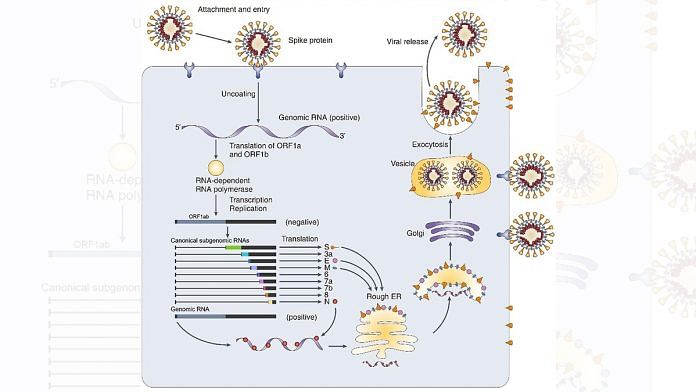New Delhi: The coronavirus pandemic continues to wreak havoc across the world, claiming more than 95,000 lives as of Friday. As a result, the scientific understanding of the virus and other research developments continue to evolve every day.
ThePrint brings you the latest developments on the Covid-19 front.
Detailed genetic architecture of SARS-CoV-2
Scientists in Korea have succeeded in dissecting the architecture of the SARS-CoV-2 RNA genome, revealing numerous new RNAs and multiple unknown chemical modifications.
This high-resolution map of SARS-CoV-2 can help better understand “how the virus replicates and how it escapes the human defense system”.
SARS-CoV-2 enters host cells and replicates to produce many smaller RNAs called ‘subgenomic RNAs’. These subgenomic RNAs are used for the synthesis of various proteins to further multiply.
Earlier studies indicated that the viral particle structure was made up of 10 subgenomic RNAs, however, according to this study, only nine subgenomic RNAs exist in a Covid-19 particle.
Researchers also found that there are dozens of unknown subgenomic RNAs, which need to be investigated further.
Also read: How the humble hydroxychloroquine has become India’s unlikely new global strategic asset
Social media posts can chart economic impact of Covid-19
Social media posts can be used to chart the economic impact and recovery of businesses in countries affected by the Covid-19 pandemic, according to researchers from University of Bristol.
In a study published in the journal Nature Communications, scientists describe a ‘real time’ method, which was accurately used during three natural disasters, that could be used to reliably forecast the financial impact of the current global health crisis.
The method relies on the assumption that businesses post more on social media when they are open and fewer when they are closed. Analysing the posting activity of a business’ social media page over time can help infer whether they are open or closed.
Using data from the public Facebook posts of local businesses collected before, during and after three natural disasters — 2015 Gorkha earthquake in Nepal, the 2017 Chiapas earthquake in Mexico and the 2017 hurricane Maria in Puerto Rico — the team charted the number of smaller urban businesses which were closed and then were able to measure their recovery post-event.
This method can help local governments target the distribution of resources better, researchers say.
Particle physicists halt dark matter search to develop simple ventilators
An international team of particle physicists have paused their search for dark matter to develop a simplified mechanical ventilator that can be mass-produced using readily available components.
Ventilators are the need of the hour during the coronavirus pandemic, with several countries facing a shortage. Over 250 physicists, engineers, physicians and others from 12 countries around the world collaborated to create Mechanical Ventilator Milano (MVM).
Dark matter researchers are experts at constructing sensitive instruments for a highly pressurised liquid form of argon to detect dark matter particles. The team decided to use their expertise with compressed oxygen and nitrogen to develop this ventilator.
Also read: Karnataka bracing for spurt in Covid-19 cases by April end, a long fight ahead: Yediyurappa
Lockdown puts children at risk of obesity
With schools shut down due to the Covid-19 pandemic, there is increasing risk of obesity among children, warn researchers.
In an article published in the journal Obesity, researchers from Columbia University in US note that school closures due to Covid-19 doubles out-of-school time for many children, exacerbating risk factors for weight gain.
Moreover, as households stock up on shelf-stable foods which are usually ultra-processed, calorie-dense comfort foods. Social distancing and stay at home orders reduce the opportunities for exercise, particularly for children living in urban areas in small apartments.
Sedentary activities and screen time are also increasing under social distancing orders. Increased screen time is associated with obesity in children because they tend to spend that time snacking.



